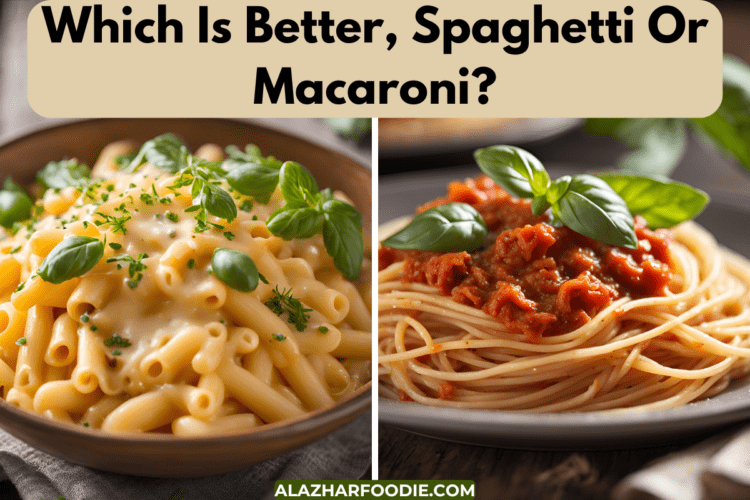Which Is Better, Spaghetti Or Macaroni?
Table of Contents
Which Is Better, Spaghetti Or Macaroni?
The primary distinction between macaroni and spaghetti resides in their size and shape: macaroni is characterized as short and tubular, whereas spaghetti is long and slender.
Definition Of Macaroni:
According to popular legend, the renowned explorer Marco Polo is credited with introducing macaroni to Italy from China; however, there is no substantial evidence to substantiate this narrative.
Contemporary macaroni is typically defined by its slightly curved, tubular form, measuring approximately 3 to 5 inches in length, and is predominantly composed of durum wheat.
While macaroni is commonly produced on a commercial scale, it can also be prepared in a domestic setting.
In the United States, elbow macaroni enjoys particular popularity, while Italy offers a diverse selection of shapes.
Definition Of Spaghetti:
Spaghetti is another well-known variety of pasta originating from Italy, distinguished by its thin and elongated structure, in contrast to the thicker and shorter macaroni.
Traditionally, spaghetti is cylindrical and measures about 20 inches in length, although shorter variants are available for convenience. This versatile pasta serves as a foundation for a wide array of dishes, ranging from simple combinations of cheese, garlic, and pepper to more elaborate recipes featuring tomatoes, meat, and sauces.
Like other pasta, spaghetti is composed of wheat and water, often enriched with vitamins and minerals. In general, durum wheat semolina is used to make spaghetti in Italy.
While it is generally white due to the use of refined flour, whole wheat options are also accessible.
There are differences in thickness between “Spaghetti” and “Spaghettini.”
Comparison Of Macaroni & Spaghetti:
- Macaroni is characterized as short, thick, and tubular, measuring between 3 to 5 inches, while spaghetti is thin and elongated, typically around 20 inches in length.
- The primary difference between the two lies in their shape and size. Macaroni pairs well with ingredients that can be accommodated within its tubular structure, such as diced vegetables, ground meat, or melted cheese, whereas spaghetti is suited for ingredients that can be twirled around its strands, such as seafood, long-simmered sauces, and fresh herbs.
- Additionally, macaroni generally cooks more quickly due to its smaller size. Its shape renders it ideal for dishes such as macaroni and cheese, pasta salads, and baked pasta, while spaghetti’s versatility allows it to excel in traditional Italian recipes, including Ag li e olio, carbonara, and Bolognese.
Caloric Content Of Macaroni & Spaghetti:
A cup of cooked spaghetti contains approximately 220 calories. In terms of weight, 100 grams of spaghetti contains about 353 calories, while 75 grams contains approximately 265 calories. Spaghetti, composed of durum wheat and water, provides carbohydrates, fat, and dietary fiber. Similarly, a cup of cooked macaroni also contains around 220 calories.
Classification Of Spaghetti:
Although spaghetti and noodles are similar in shape, they are not the same thing. The National Pasta Association defines a noodle as containing a minimum of 5.5% egg content, which spaghetti does not fulfill. Because spaghetti is created with just water and durum wheat and no eggs, it is therefore considered pasta.
Taste Comparison: Spaghetti vs. Macaroni
Both spaghetti and macaroni are types of pasta derived from durum wheat, and their flavors are generally comparable when produced by the same brand. The preference between the two often depends on their intended application in various dishes.
Impact Of Pasta Shape On Taste:
The shape of pasta can influence its taste due to variations in thickness and texture, which affect sauce absorption. Ribbed pasta tends to absorb sauce more effectively than smooth varieties.
Each shape serves a specific purpose, with the general guideline being that thin pasta pairs well with lighter sauces, while thicker pasta complements richer or creamier sauces.
Recommended Noodle-Sauce Pairings:
- Thin long noodles: Best suited for light sauces such as tomato, garlic, and olive oil.
- Flat long noodles: Ideal for rich or creamy sauces, as their surface area accommodates such dishes effectively.
- Long tube noodles: Complement bold flavors, such as crushed red pepper flakes or pancetta.
- Short tube pasta: Versatile for use in soups, salads, casseroles, and more.
- Macaroni: Particularly well-suited for baked pasta dishes featuring creamy cheese sauce.
Frequently Asked Questions:
Does macaroni and spaghetti taste the same?
The various types of pasta produced by the same manufacturer may exhibit similar flavors; however, they possess distinct textures, and their shapes are specifically designed to enhance the adherence of accompanying sauces.
Which is better, spaghetti or macaroni taste?
Both spaghetti and macaroni fall under the broader category of pasta, which is defined as a leavened dough composed of wheat flour, eggs, and water.
Pasta can present a range of flavors, including tangy, salty, spicy, or sweet, with its taste and aroma contributing significantly to its popularity. The flavor and texture of pasta can also differ based on the type of wheat utilized in its production.
For instance, pasta crafted from durum wheat semolina tends to have a more pronounced nutty and earthy flavor, along with a firmer and chewier texture compared to pasta made from soft wheat flour.
Difference between macaroni and penne
Macaroni encompasses a variety of pasta shapes that range from small to medium in size, while penne is characterized as a cylindrical pasta with angled ends. The fact that penne is categorized as a kind of macaroni is noteworthy.
Is macaroni healthy?
Macaroni can be incorporated into a healthy diet, particularly when it is made from whole wheat and prepared in a balanced manner. As macaroni is derived from durum wheat, it serves as a nutritious option, containing essential nutrients such as iron, folate, magnesium, and dietary fiber.
Is it OK to eat spaghetti daily?
Incorporating macaroni into meals can facilitate the inclusion of vegetables and healthy fats, such as those from nuts and olive oil, as well as various pasta sauces. According to Meyer, “It is acceptable to include macaroni in a regular diet, potentially on a daily basis.”
Is macaroni junk food?
Pasta can also be a part of a diet that is well-balanced. Moderate consumption of pasta may assist in regulating fat and sugar intake, countering the misconception that pasta invariably contributes to weight gain. It is essential to recognize pasta’s potential as a nutrient-dense side dish.
Is macaroni better than rice?
In terms of caloric and carbohydrate content, rice is generally considered superior. However, if the objective is to increase protein and fiber intake, pasta is the more advantageous choice. Both rice and pasta can play a role in a healthy diet, and given the relatively minor nutritional differences, the decision often hinges on personal preference.
Referred By Vocal Media Article Written By Mustafa Rangoonwala.
Recommended Articles:
How To Remove A Built In Fridge?
How Long Can A Jackery 1000 Run A 12V Fridge?
Are scrambled eggs a healthy breakfast option?



